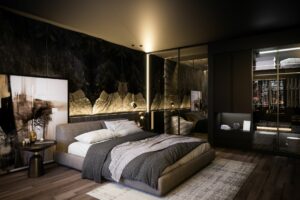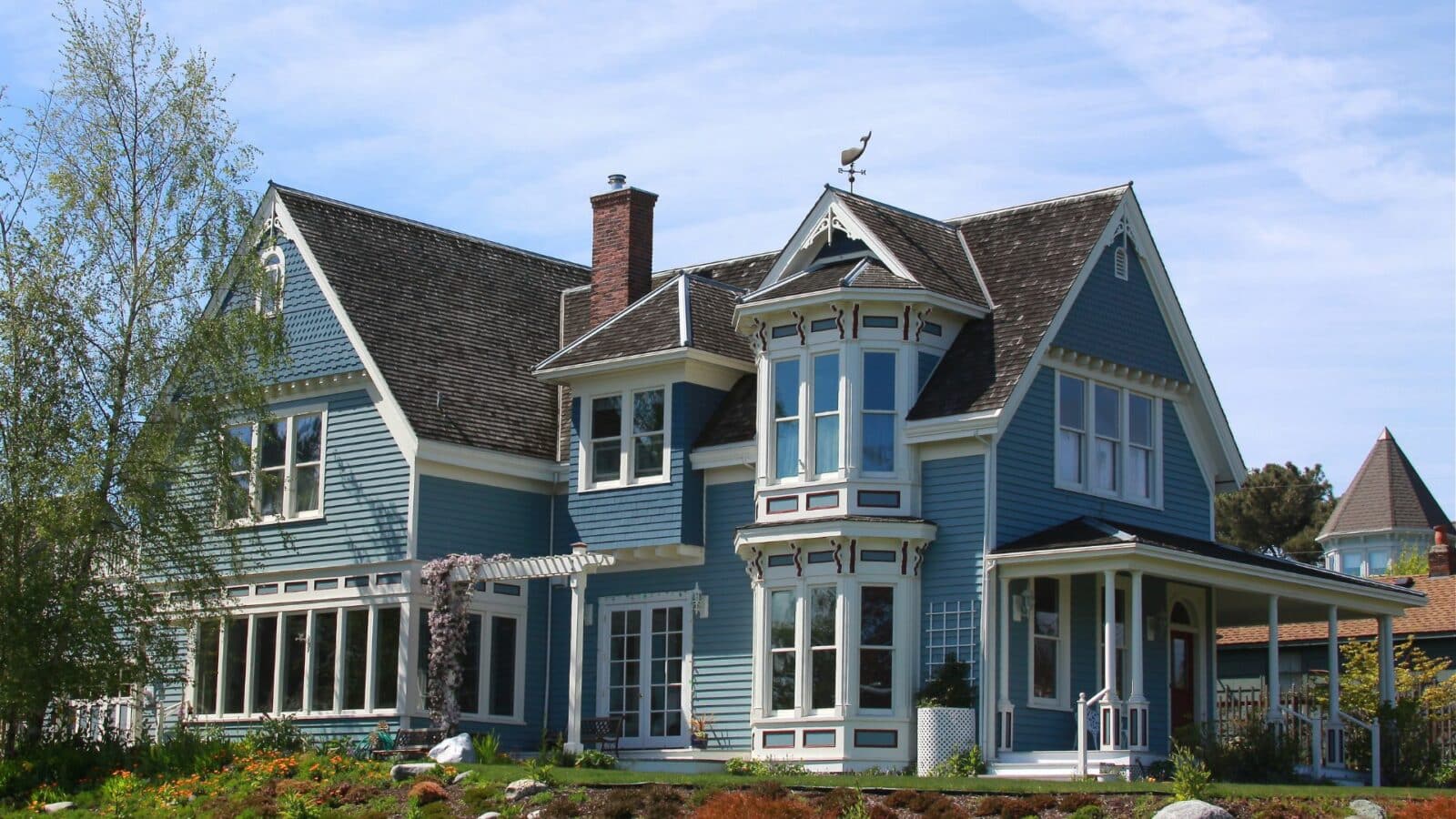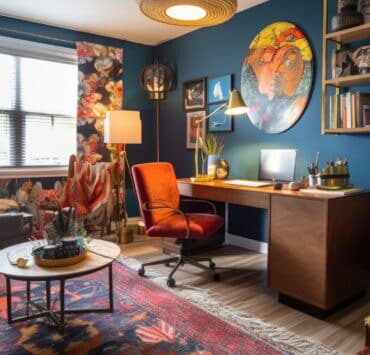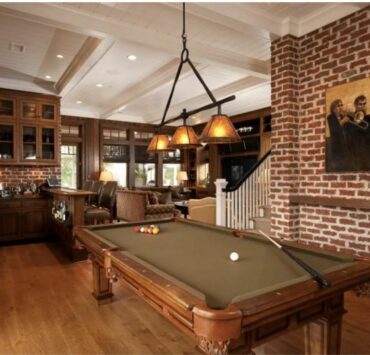The exterior of your home is the first thing that people see, and it sets the tone for what they can expect inside. A well-planned exterior home design can make your space stand out in the neighborhood, increase its curb appeal, and even boost its value. In this blog, we’ll share exterior home design ideas for your next home remodel.
Exterior Home Design Ideas
Tudor Style
Characterized by its steeply pitched gable roofs, the Tudor-style exterior home design features a decorative half-timbering and tall, narrow windows with small panes. Tudor homes often have a medieval appearance, bringing a sense of history and charm.

Cottage Style

These homes are quaint and cozy, often featuring a small, one-story layout. They typically have pitched roofs, bay windows, and an abundance of natural materials like stone and wood, creating a warm, inviting feel.
Barn Style

Inspired by the simplicity and utility of traditional barns, barn-style homes often have a straightforward, rectangular footprint, large windows, and high ceilings. They frequently use rustic materials and incorporate large, open interior spaces.
Mediterranean Style

This style is influenced by the architecture of countries around the Mediterranean Sea. Features include stucco walls, red tile roofs, arched doorways, and outdoor spaces that blend seamlessly with the indoors. These homes are particularly suited to warm climates.
Spanish Style

Similar to Mediterranean homes but with a distinct Spanish influence, these houses often have stucco exteriors, terracotta roof tiles, and wrought-iron details. Courtyards and elaborate tile work are also common features.
Modern Home Exterior

Modern home designs emphasize clean lines, large windows, and open floor plans. Materials like glass, steel, and concrete are commonly used, and there’s a strong focus on simplicity and function.
Craftsman Style

Known for its attention to craftsmanship and materials, Craftsman homes often feature low-pitched roofs, wide eaves with exposed rafters, porches with thick square or round columns, and hand-crafted stone or woodwork.
Farmhouse

Modern farmhouses mix traditional country aesthetics with contemporary design. Key elements include large porches, wood siding, and practical, spacious interiors. The modern farmhouse trend emphasizes comfort and casual living.
Victorian

These homes are elaborate and ornate, with intricate trim, bright colors, steep rooflines, and rounded towers. Victorian architecture was popular in the late 19th century and is still beloved for its character and detail.
Colonial

Colonial homes are stately and symmetrical, with evenly spaced shuttered windows, red brick or wooden exteriors, and columns or pillars. The interior is equally symmetrical, featuring a central hallway with rooms branching off.
Cape Cod
Originating in the 17th century, Cape Cod homes are simple and symmetrical with steep roofs, dormer windows, and a central front door. The exterior is typically clad in wood siding or shingles, painted in light colors to reflect the coastal environment.
French Country

French Country homes blend rustic and refined elements, featuring soft, curved lines, stucco and stone exteriors, and steeply pitched roofs. These homes often include tall, narrow windows and wooden accents.
Greek Revival

This style mimics ancient Greek architecture with its tall columns, symmetrical shape, and gabled or hipped roofs. The exteriors are often white or light-colored to resemble marble.
Prairie Style

Developed by Frank Lloyd Wright, Prairie homes emphasize horizontal lines, flat or hipped roofs with broad overhangs, and windows grouped in horizontal bands. These homes blend into the landscape and often have open interior floor plans.
Art Deco

Art Deco architecture is known for its bold, geometric shapes, rich colors, and lavish ornamentation. Exteriors may feature stucco, smooth stone, or concrete with decorative elements like metal trim and glass blocks.
Mid-Century Modern

Popular in the mid-20th century, these homes are characterized by large windows, open spaces, and the integration of indoor and outdoor living. They often feature flat planes, geometric lines, and a minimalist aesthetic.
Ranch Style

Ranch homes are one-story structures with a simple, open layout and a long, low profile. They often have large windows, an attached garage, and a sliding glass door leading to a backyard.
Italianate

Inspired by 16th-century Italian Renaissance architecture, Italianate homes have tall, narrow windows, wide eaves with decorative brackets, and low-pitched or flat roofs. The exteriors often feature ornamental detailing around windows and doors.
Georgian

Known for their symmetry and proportion, Georgian homes have paneled front doors topped with decorative crowns, paired chimneys, and a formal aesthetic. Materials typically include brick, stone, or wood.
Contemporary

Irregular or asymmetrical shapes, extensive use of glass, innovative materials, and a focus on eco-friendly practices, characterize contemporary home design. These homes often blend textures and materials for a dynamic appearance.
Beaux-Arts

Characterized by its grandiose and elaborate design, Beaux-Arts architecture features classical details, large windows, and heavy ornamentation. These homes often have impressive facades with sculptures, columns, and decorative stonework.
Colonial Revival

This style draws from early American colonial architecture, combining elements from several colonial styles. Features often include symmetrical facades, multi-pane windows, columns, and pediments, blending traditional design with modern comforts.
Dutch Colonial

Known for their gambrel roofs, which resemble a barn, Dutch Colonial homes often have a broad, double-pitched roofline, flared eaves, and dormer windows. The use of brick or shingle siding is common.
Gothic Revival

Inspired by medieval Gothic architecture, these homes feature pointed arches, elaborate detailing, steep gable roofs, and decorative tracery. The style is dramatic and often has a storybook appearance.
Italian Renaissance Revival

Mimicking the Renaissance architecture of Italy, these homes are characterized by their symmetry, proportion, and classical detail, including columns, pilasters, and rounded arches. Materials often include stone or stucco.
Neoclassical

Neoclassical homes are inspired by the classical architecture of ancient Greece and Rome, featuring columns, porticos, and a symmetrical shape. The emphasis is on simplicity, elegance, and grandeur.
Queen Anne

A sub-style of Victorian architecture, Queen Anne homes are known for their asymmetrical designs, textured exteriors, towers or turrets, and expansive porches. Decorative trims and multi-colored schemes are common.
Shingle Style

This American architectural style is characterized by the extensive use of shingles on the exterior walls and roofs. These homes often blend into their surroundings and feature irregular shapes, porches, and asymmetrical facades.
Stick Style
Predominantly found in the late 19th century, stick-style homes feature decorative woodwork (or “sticks”) that emphasize the structural framing of the building. The style is recognized for its exposed beams, rafters, and diagonal or vertical stickwork on the exterior.
Victorian Stick

An evolution of the Stick Style, Victorian Stick homes incorporate more ornate details and decorative elements, combining the structural emphasis of Stick Style with the elaborate aesthetics of Victorian architecture.
Embracing Diversity in Exterior Home Design
Exploring exterior home design reveals a fascinating tapestry of architectural styles, each with its unique charm and history. From the grandeur of Beaux-Arts to the simplicity of the Shingle Style, the diversity of designs showcases humanity’s creative spirit and adaptability to different environments and cultural influences. Whether you’re drawn to the symmetry and classic beauty of Neoclassical homes or the rustic, storybook allure of Gothic Revival cottages, there’s a style out there that resonates with every homeowner’s dream.
In learning the vast array of exterior home remodeling designs, we find not only inspiration for our living spaces but also a deeper appreciation for the architectural heritage that shapes our communities. The journey through these styles is a reminder of the importance of preserving historical architecture while encouraging innovative designs that reflect our evolving lifestyles.
Related posts:
 Clever Storage Solutions: Small Kitchen Cabinets and the Best Ideas
Clever Storage Solutions: Small Kitchen Cabinets and the Best Ideas
 Small but Stylish: Powder Room Design Ideas for a Chic and Functional Space
Small but Stylish: Powder Room Design Ideas for a Chic and Functional Space
 Retreat to Tranquility: Bedroom Design Ideas for 2024
Retreat to Tranquility: Bedroom Design Ideas for 2024
 Men’s Bedroom Design Ideas: Creating a Stylish and Masculine Retreat
Men’s Bedroom Design Ideas: Creating a Stylish and Masculine Retreat
 Modern Apartment Design Ideas for 2024
Modern Apartment Design Ideas for 2024



